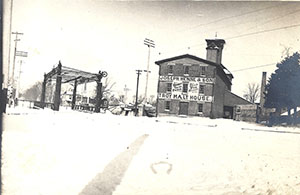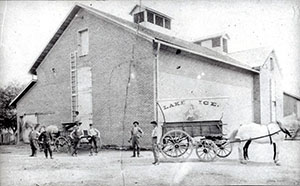Down through Troy’s 200-year history, many businesses have come and gone. One of the most interesting of the long-gone businesses is the wintertime cutting and selling of ice from local waterways. For decades, ice “harvested” in Troy was sold and used in towns both near and far away. This was an important business in the days before the invention of the modern refrigerator and freezer for the cold storage of food.
The business of cutting and selling ice to distant markets is believed to have started in the late 1830s or early 1840s, after the opening of the Miami and Erie Canal in Troy in 1837. Prior to that time, there was not a good way to get the ice to markets in other states. (Ice was probably cut for local use prior to that time.) In his book TROY THE NINETEENTH CENTURY Troy historian Thomas Bemis Wheeler wrote, “With the coming of the Canal Troy became a center for the cutting, storing and shipping of ice. E.B. Scott of Cincinnati built two ice storage houses on the Culbertson and Dye millpond (near today’s Dye Mill Road) and another one on the canal where the two bodies of water come close together.” Over time, other businessmen used a variety of buildings/warehouses in Troy to store ice before shipping it to other places.
Descriptions about how the Troy ice warehouses were built have not been located. Stories of ice warehouses in other parts of the United States indicate that during winter, ice and snow were put into buildings with sawdust or straw used to insulate the ice. Ice packed with such insulation material could keep ice from melting even into the summer months. Some warehouses may have been built with part of the building underground, which also helped keep ice frozen.
The year 1847 is remembered as being a very good year for the harvesting of Troy ice. Wheeler says in his book that E.B. Scott from Cincinnati had 25 men harvesting ice with “labor-saving machinery.” Local ice was 18 inches thick that year. By the end of February 1847, “Scott had 70 canal boat loads of ice awaiting shipment to Cincinnati and down the Mississippi.” Along with Scott, fifty other people are said to have cut ice with axes and saws that winter for other Troy businessmen. The ice was cut into blocks of 9 inches by 11 inches by 18 inches.
Many times in the 1800s, Troy ice warehouses were filled to capacity as the storage owners waited for the canal to thaw so the boats could transport the ice distant markets.
The 1870s brought another change to the ice business. In 1876, a Hydraulic water system came into use in Troy. It was originally installed in Troy to bring pressurized waterpower to businesses, but its biggest use seem to come from a Hydraulic water basin built near the Miami County fairgrounds. The half-mile long basin became a favorite place for fishing and boating. Because the water in the basin had been under pressure, it was clear. Ice from the basin was highly popular because of its clarity. Troy distiller Lewis Hayner bought the Hydralic land and water rights in 1877. He then built an ice house and rented the rights to cut the ice and store it in his ice house to various parties: a company named the Crystal Ice Company, Troy brewer Joseph Henne, and several unnamed individuals. Historical records indicate that the winter of 1876-1877 was a great year for Troy ice cutting. More than 32,000 tons of ice was harvested that winter.
Ice continued to be hand-cut in Troy into the 20th century. Troy newspapers refer to men cutting on the local bodies of water through 1908. The practice of cutting ice on the Miami and Erie Canal may have ended sooner than on the Great Miami River or local ponds. In the early 1900s, canal water was said to be “dirty.” The canal in Troy was filled in during the 1920s.
New ways of making ice began in the early 1900s. The Miami Union newspaper of January 16, 1902 ran a story about Troy’s Peckham Coal and Ice Company that mentions a way to make ice rather than cut it from a natural body of water. “Last summer they (the Peckham Company) bought artificial ice from Piqua, shipped it to Troy via the Miami Valley Railway. They are building an ice plant near the (Troy) Buggy Works that will make ten tons a day.”
In the first half of the 20th century, many Troy homes had an ice box. The ice box was the predecessor to the modern refrigerator; older Trojans remember it from their childhood days. It was the kitchen appliance where food was stored and preserved in low temperatures. As the name describes it, it was a metal box kept cold by blocks of ice placed inside it.
The Troy Ice and Coal Company was probably the last company to home deliver ice in Troy. A photo taken in 1946 shows company drivers standing next to their trucks. The company had routes not only in Troy, but in Christiansburg and Verona.
Local writer David L. Smallenbarger once wrote an essay titled “Troy Icemen.” He said that the icemen were “…familiar and friendly faces in Troy homes and streets.” If a homeowner wanted a delivery of ice, they placed a card in the front window of their home with the number of pounds to be delivered. Ice was delivered in increments of 25 pounds (25 pounds, 50 pounds, 75 pounds, etc.).
Smallenbarger’s essay says that the icemen “…were piviotal players in providing services to Troy homes” back in the days before the modern freezer or refrigerator.
Ice is still part of everyday life Troy. It continues to be made, delivered and sold commercially, mostly with beverages. Home delivery of ice and icemen are now part of history. As time goes by, fewer people remember the iceman and his once familiar call at the front door “ice man!”
For further information about the icemen who served Troy, contact The Troy Historical Society at (937) 339-5900 or by email at This email address is being protected from spambots. You need JavaScript enabled to view it.. Information is also available at the Troy-Miami County Public Library Local History Library, 100 West Main Street in Troy.

A winter scene of the Henne Brewery building that stood near a bridge of the Miami and Erie Canal. The brewery used and stored ice cut from local waterways. The building may have been on Water St.

Troy in winter looking east from the Market Street Bridge. Troy would have looked like this when ice-cutting was done.


